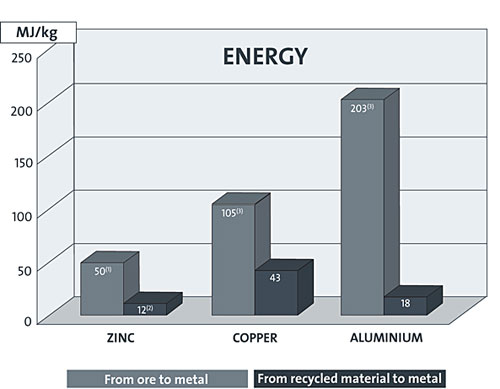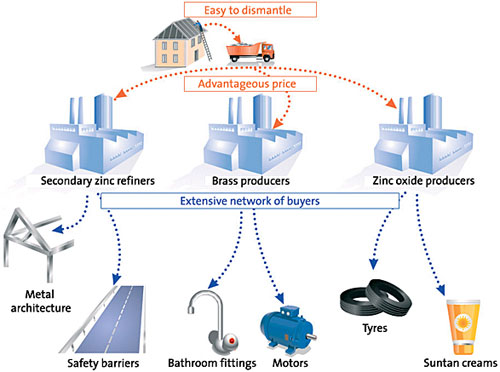Zinc: The Sustainable Choice among Architectural Metals
Sustainability Qualities of Zinc
According to the May 2008 issue of MetalMag, the trade journal for processed metals, "As the building industry migrates toward green practices, zinc will continue to play an increasingly important role in the development of truly sustainable buildings." This statement is readily backed up by a number of observable sustainable qualities of zinc products including a life expectancy of more than 100 years, a lower environmental foot print than competing materials, little or no maintenance over the life-time of the product and no replacement required over the life-time of building. More specifically, the following traits of these materials that readily contribute to green building design have been identified by the International Zinc Association and several manufacturers:
• Life Cycle Analysis: The long term service life implication of buildings has received more attention in recent years, particularly during the current process of developing the International Green Construction Code (IGCC). Among the provisions of the current Public Version 1.0, Chapter 5 of this emerging standard addresses Material Resource Conservation and Efficiency and calls for a Building Service Life Plan to be included in the construction documents for the project and provides detailed requirements for the plan. Of particular note is the identification of 100-year and 200-year service life elements. The long life expectancy of zinc will readily support this requirement.
Separate from requirements of codes and standards, many clients look for very positive Life Cycle Analysis (LCA) studies on building material and product choices as well. The International Zinc Institute has used LCA as a standardized scientific method for systematic analysis of all mass and energy flows as well as environmental impacts attributed to a product system, from raw materials acquisition to end-of-life management. The terms "cradle to grave," "cradle to cradle" and "total cost of ownership" describe this overall full life cycle concept of materials. Reviews of LCA studies are not only a matter of simple longevity, but also of the costs necessary in maintaining a material throughout its service life. To take roofs as an example, in a 2004 study conducted by Ducker International, owners and property managers reported performing little or no maintenance on their metal roofs (to be fair, the study included all types of metal roofs, not just zinc). A comparison of maintenance costs over the life of the roof for metal versus asphalt and single-ply membranes showed that owners of metal roofs spent approximately 3 percent of total installed costs on maintenance, versus 28 percent for asphalt and 10 percent for single-ply membranes. More specific studies comparing zinc roofing to other long lasting roofing materials have shown that, when including a credit for recycling of material at the end of its useful life, zinc has a noticeably smaller environmental footprint and a more favorable life cycle result than aluminum, copper, stainless steel, or cement tiles.
• Reducing embodied energy in materials: Zinc production is friendlier to the environment than other metals through its comparatively low embodied energy. Embodied energy includes the total amount of non-renewable energy needed to create one unit of a finished product, including raw material extraction, transport, manufacturing, assembly and installation, and in detailed calculations, to maintain it during its useful life and dispose of afterwards. Among the non-ferrous metals used in building, zinc has the lowest embodied energy. It is the least energy intensive to produce, requiring one fourth the energy of aluminum, and one third that of copper or stainless steel. Zinc is less energy intensive to extract than many other metals, and requires lower heat and therefore less energy to process. A complete embodied energy balance sheet must also take into account the energy value of labor to repair or remove old systems such as asphalt roofs, the energy cost of the replacement materials, the energy used in transportation of materials on each occasion, and impacts at landfills. Use of a longer lasting material such as zinc eliminates the cost and embodied energy of such removal or repairs of other roofing systems with shorter service lives. By contrast, at the end of the service life of zinc, an estimated 95 percent of the energy content embodied in a zinc product is conserved during recycling meaning that significantly less energy is used to produce zinc building products when recycled material is used instead of mining and processing new ore.
• Selecting materials with recycled content: Very few common building materials, including those considered to have low embodied energy, can match the recyclability of zinc material. Architectural-grade zinc must be very pure, and so it contains higher percentages of pure ore than industrial-grade zinc. However, once the pure architectural alloy has been created, it can be recovered and reprocessed for use in new architectural products. Some current zinc product manufacturers achieve very high levels of this recycled content in their architectural zinc, over 45 percent, almost all of which is post- consumer content. Specifying recycled content in zinc products is very realistic and achievable as a result.
 |
Embodied energy in different types of architectural metals Photo: VM Zinc USA |
Â
• Ability to recover and recycle at end of useful life: Removal and disposal of typical building materials can be a complex and costly job, and the resulting debris may have low or no value ending up in a landfill producing the associated costs for freight and disposal plus the long-term cost to the environment. However, of the millions of tons of discarded building materials taken to landfills every year, there is hardly a scrap of architectural zinc. This is because metallic zinc can be recycled indefinitely without loss of its chemical or physical properties. This theoretically infinite recyclability is, in fact, being approached in reality in the case of zinc used in buildings. The overall recycling rate for architectural zinc recovered from renovations and removal from old building is over 90 percent in some countries because of its high value. In Europe, buildings whose zinc parts outlasted them are numerous yet virtually no zinc on a building ever goes to a landfill. Recycling of zinc is a well-established industry because products can be recovered easily at the end of their life and there is an extensive network of buyers offering advantageous prices.
 |
The ability to recycle and re-use zinc at the end of the service life of a building. Photo: VM Zinc USA |
Â
• Reducing construction waste: The standardization of sizes of zinc products means that less cutting and scrap material may be produced during any given project. Nonetheless, any zinc construction wastes can easily be separated from other metals and sent to any local metal scrap dealer. In the United States, zinc is commonly reused by the galvanization industry or may be fabricated into other products. Even small amounts of scrap zinc generated on jobs are valuable and readily sold.
• Selecting low-emitting or no-emitting materials: Part of the beauty of zinc metal comes from its natural coloration which means that no additional paints, sprays, or other treatment is needed. As a result, manufacturers, fabricators, installers, and users will never need to apply any other coatings on the metal. Consequently, no Volatile Organic Compounds (VOCs) ever need to be introduced that might generate emissions which are contrary to healthy indoor environmental quality.
• Innovation in applications: Because of the versatility and wide range of possible building applications of zinc, it is possible to be very creative in its use to achieve sustainable building designs. Some of these innovations can take the form of advanced building envelope solutions such as rain screen designs, roofing variations, sun screens, etc. Zinc based batteries and fuel cells can be a contributing portion of an onsite renewable energy solution for buildings. Architects looking for advancing the state of green building design through innovation will find plenty of opportunity to pursue creative solutions when considering zinc for those solutions.









